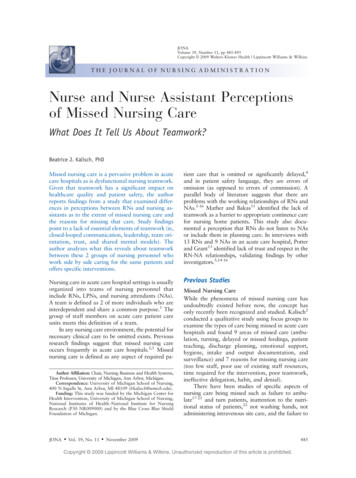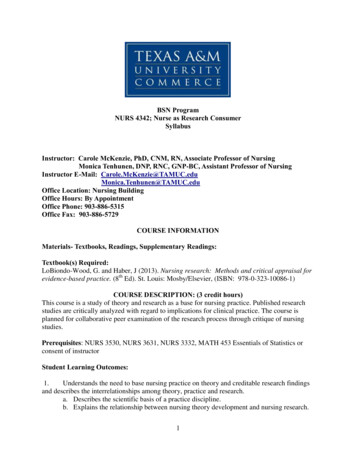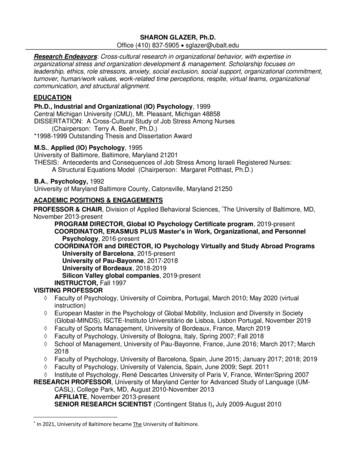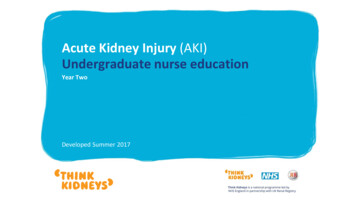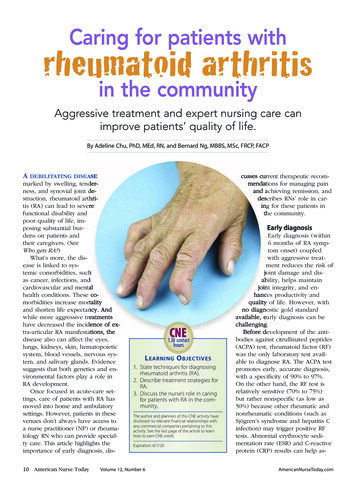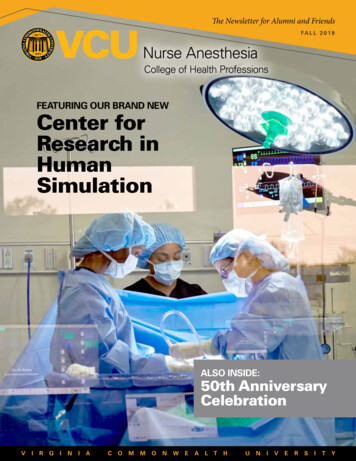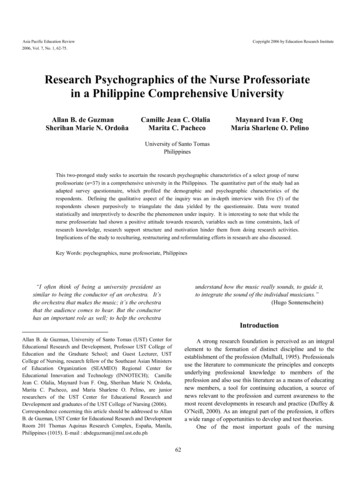
Transcription
Asia Pacific Education ReviewCopyright 2006 by Education Research Institute2006, Vol. 7, No. 1, 62-75.Research Psychographics of the Nurse Professoriatein a Philippine Comprehensive UniversityAllan B. de GuzmanSherihan Marie N. OrdoñaCamille Jean C. OlaliaMarita C. PachecoMaynard Ivan F. OngMaria Sharlene O. PelinoUniversity of Santo TomasPhilippinesThis two-pronged study seeks to ascertain the research psychographic characteristics of a select group of nurseprofessoriate (n 37) in a comprehensive university in the Philippines. The quantitative part of the study had anadapted survey questionnaire, which profiled the demographic and psychographic characteristics of therespondents. Defining the qualitative aspect of the inquiry was an in-depth interview with five (5) of therespondents chosen purposively to triangulate the data yielded by the questionnaire. Data were treatedstatistically and interpretively to describe the phenomenon under inquiry. It is interesting to note that while thenurse professoriate had shown a positive attitude towards research, variables such as time constraints, lack ofresearch knowledge, research support structure and motivation hinder them from doing research activities.Implications of the study to reculturing, restructuring and reformulating efforts in research are also discussed.Key Words: psychographics, nurse professoriate, Philippines1“I often think of being a university president assimilar to being the conductor of an orchestra. It’sthe orchestra that makes the music; it’s the orchestrathat the audience comes to hear. But the conductorhas an important role as well; to help the orchestraunderstand how the music really sounds, to guide it,to integrate the sound of the individual musicians.”(Hugo Sonnenschein)IntroductionAllan B. de Guzman, University of Santo Tomas (UST) Center forEducational Research and Development, Professor UST College ofEducation and the Graduate School; and Guest Lecturer, USTCollege of Nursing, research fellow of the Southeast Asian Ministersof Education Organization (SEAMEO) Regional Center forEducational Innovation and Technology (INNOTECH); CamilleJean C. Olalia, Maynard Ivan F. Ong, Sherihan Marie N. Ordoña,Marita C. Pacheco, and Maria Sharlene O. Pelino, are juniorresearchers of the UST Center for Educational Research andDevelopment and graduates of the UST College of Nursing (2006).Correspondence concerning this article should be addressed to AllanB. de Guzman, UST Center for Educational Research and DevelopmentRoom 201 Thomas Aquinas Research Complex, España, Manila,Philippines (1015). E-mail : abdeguzman@mnl.ust.edu.phA strong research foundation is perceived as an integralelement to the formation of distinct discipline and to theestablishment of the profession (Mulhall, 1995). Professionalsuse the literature to communicate the principles and conceptsunderlying professional knowledge to members of theprofession and also use this literature as a means of educatingnew members, a tool for continuing education, a source ofnews relevant to the profession and current awareness to themost recent developments in research and practice (Duffey &O’Neill, 2000). As an integral part of the profession, it offersa wide range of opportunities to develop and test theories.One of the most important goals of the nursing62
Research Psychographicshave the necessary scholarly competence in research. Suchalarming observations invite the need to probe into otherfactors that underlie the slow research pace in the country.Though today’s universities are challenged by varioustrends such as quantitative expansion, differences ininstitutional structures and study programs, and financialrestrictions (de Guzman & Torres, 2004), their commitment tothe life of the mind through the scholarships of discovery,integration, application, and teaching (Boyer, 1997) remainsan imperative. Today, more than ever, there is no greaterchallenge to the professoriate than the continuing development ofthe “specialness” of the university (Goldman, 2000:151).With nursing as one of the popular fields in the country andwith a number of higher education institutions declared by thePhilippine Commission on Higher Education as Centers ofExcellence, it is interesting to look at how research as one ofthe missional triptych of the university is viewed collectivelyby the nurse professoriate. Specifically, this investigationdescribed the nurse professoriate’s attitude toward researchrelative to (a) feelings on research; (b) perceptions ofresearch; (c) research awareness; (d) research interest; (e)research engagement benefits and payoffs; and (f) resourceutilization; and ascertained the degree to which psychographiccharacteristics of the nurse professoriate relate to theirdemographic profile.profession is the production of an evidence-based body ofliterature. As a valuable lens in the practice of the profession,research offers an opportunity to explore issues of clinicalconcern; seeks an avenue for personal advancements;validates traditional practices, or justifies change in the statusquo (Morrison, 1998); allows better comprehension of clinicalproblems and ways of solving or removing these problems(Kenty 2001); and helps the profession in maintaining itscredibility and respect (Duffey & O’Neill, 2000).While nursing has become the most populous among thehealth professions, it remains to be a minor contributor in theadvancement of knowledge frontiers. As one of the buildingblocks in the promotion of research culture, the nurseeducator has a crucial role in encouraging future nurses tobecome interested in nursing research during their training(Thomas, 1998; Athlin, Björkström, Hamrin, & Johansson,2003). However, previous studies (see Dennis, 1991; Kyei,1993; Hicks, 1995; Mulhall, 1995; Tsai, 2000) pointed outthat a number of contextual variables relate to the faculty’snegative attitudes toward the conduct of research. Thesevariables may be categorized into structural, procedural andpersonal dimensions. The structural dimension refers to thesupport extended by the administrators and colleagues infacilitating the completion of a research project. Theprocedural dimension encompasses the adoption of codifiedpolicy statements that govern the overall research protocol.The personal dimension pertains to the richness of exposureto and substantial understanding of the nurse researchers ofthe research process. Impliedly, the profession has to workhard to change the attitudes of many of its members in orderthat research in its widest sense is seen to be useful to theprofession and the people it cares for (Hicks, 1995). Evidencefrom the literature suggests that education can be one of thefactors in motivating and positively altering the attitudes ofnurses towards research (Thomas, 1998). Students areinfluenced and shaped dramatically by the instructor’steaching style and input. In order to positively influencestudents of nursing regarding research, teachers themselves,are required to possess research skills and at the same time, toincorporate research into their teaching (Thomas, 1998).In 1991, a nationwide survey on the state of the qualityof Philippine Education was conducted. This study which wasspearheaded by the Congressional Commission on Education(EDCOM) noted the proliferation of social demand fields.These fields of study are said to be popular to both parentsand students. Among the popular fields are businessadministration, health-related sciences and engineering.Bernardo (1998) noted that many faculty members do notMethodStudy Site and InstrumentationThis study was conducted at one comprehensiveuniversity in the Philippines-- a Level II accredited institutionand a Center of Excellence (COE) granted by the Commissionon Higher Education (CHED). For the purpose of this study,the said university shall be identified as University A.Quantitative and qualitative approaches to research wereemployed in order to achieve the purpose of this study.Quantitative data were gathered through questionnaires, whilequalitative data were generated from interviews.The 30-item Attitude Scale-Toward Research (ASTR)originally developed by Noemi S. Catalan (1997) was adaptedby the present study. The original instrument which was ratedon a 5-point Likert Scale contains 10 items each of cognitive,affective and response tendencies. One half of the items werepositively worded, while the other half was negativelyformulated. The ASTR was initially pilot-tested on 26teachers who were convened for the purpose of discussing the63
Allan B. de Guzman et al30 minutes and was tape-recorded. The interviewees wereallowed to talk as freely as possible about the outlined issues.The interview guide served only as a basic checklist forcovering all the relevant topics. Follow-up questions wereasked to seek clarification and further details of the factorsmentioned. The interviews were done to further support thedata gathered from the survey.career path of Ph.D. degree holders. As the results of pretesting disclosed the feasibility of achieving the purpose ofthe original study conducted in 1997 on “Teachers’ Attitudestowards Research”, the instrument was utilized in 1997 byCatalan with 379 university teacher respondents and by deJesus in 2000 with 155 teacher respondents. For the purposesof the present study, the modified instrument was divided intothe following parts: (1) demographic data of the respondents(2) professional variables (3) understanding and knowledge ofresearch (4) a four-point Likert Nursing Attitude Scale (NAS)constituting the respondents’ research psychographics and (5)technological ability. The modified 4-point Likert Scale wasused to avoid central tendency effect (de Guzman, Villuga,Olalia, 2005). Since previous studies which made use of theASTR did not indicate the reliability index of the instrument,the present study attempted to report the instrument’sreliability index by fielding it to a group of nurse educatorsand practitioners (n 29) enrolled in a graduate educationprogram in one comprehensive university in the capital in thePhilippines. Results of Cronbach reliability testing yielded acoefficient of .88.Although not evident in the Likert scale, the statementsare categorized in six parts as follows:StatementsAreas of Concern1-7Are associated with the feelings of nursingfaculty towards researchAre directed at finding the subjects’perceptions on researchAre related to finding out the awareness ofthe faculty of researchAre concerned with whether the subjects areinterested in researchTry to relate the benefits and payoffsreceived from research engagementDescribe resource utilization and availabilityto the y-one (61) faculty members handling major coursesin nursing were asked to participate in the study. However,only 37 instruments were returned. This represents a 61.66percent retrieval rate. Respondents were informed about thenature and purpose of the investigation. For the qualitativepart of the study, five faculty members were purposivelychosen to serve as respondents to a semi-structured interviewbased on their availability. It should be noted, however, that atypical nurse professoriate in the Philippines renders 40 hoursof service covering both teaching and clinical areas.Ethical ConsiderationsPermission for the study was obtained from the Dean ofthe college. Participation was voluntary, confidentiality wasguaranteed and informed consent was obtained. To ensureanonymity, no identification was included in the survey.Data AnalysisAll analyses were conducted using SPSS for Windows,Version 14.0. Both descriptive and inferential analyses wereperformed. With regard to the 4-point attitude scale, negativestatements were changed to positive for convenience ininterpretation. Data yielded by the questionnaires were treatedusing various statistical tools, namely: percentage, mean,standard deviation, multiple correlation analysis and regressionanalysis.When all interviews were completed, they were transcribedverbatim. Although there were a number of approaches toqualitative data analysis, the approach in this study was to usea form of thematic content. Transcripts from the respondentswere analyzed by the researchers and the data were convertedinto systematic categories. Themes were then extracted as theinterviews were reviewed. Clusters of themes werecategorized which served as a guide for more subsequentreviews of the transcripts. Specific statements were identifiedto be used as supportive evidence for significant statisticalThe sentences were stated positively with a score of one(1) indicating the strongest agreement, and four (4), indicatingthe least agreement. In this way, low scores would relate topositive attitudes towards research.The semi-structured interviews were conducted on aselect group of nursing faculty, following the six (6) areascovered in the survey questionnaire. The five faculty memberswere chosen on the basis of their availability for interview atmutually convenient times. Each interview lasted for about64
Research Psychographicsdata gathered from the survey questionnaires.of the faculty are described in Table 1. As the table indicates,there is a preponderance of female teachers, 29 (78.4%) overtheir male counterparts, 8 (21.6%). As to their age 23 (62.1%)belong to the 20-30 age group. Twenty (54.1%) of the facultymembers were married. Twenty-one (56.76%) of therespondents have bachelor of science in nursing degrees.Majority (75.67%) are currently at the instructor levelworking on a full-time basis (97.3%) and have been with theuniversity for 0-10 years (75.67%) and have more than 24ResultsDemographic Characteristics of RespondentsThe number of completed questionnaire was 37, givingan overall response rate of 61.66%. Demographic characteristicsTable 1. Demographic Profile of Respondents (n 37)ProfileCount%ProfileGenderCount%Years of 1A
Allan B. de Guzman, University of Santo Tomas (UST) Center for Educational Research and Development, Professor UST College of Education and the Graduate School; and Guest Lecturer, UST College of Nursing, research fellow of the Southeast Asian Ministers of Education Organization (SEAMEO) Regional Center for Educational Innovation and Technology (INNOTECH); Camille Jean
